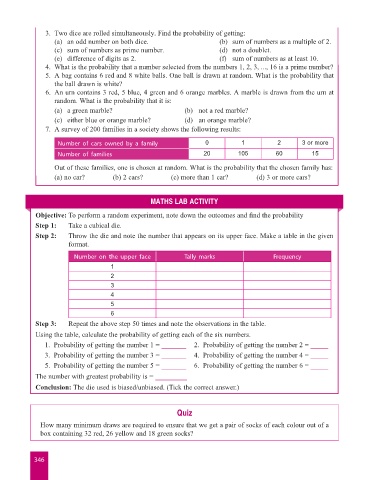Page 354 - Start Up Mathematics_8 (Non CCE)
P. 354
3. Two dice are rolled simultaneously. Find the probability of getting:
(a) an odd number on both dice. (b) sum of numbers as a multiple of 2.
(c) sum of numbers as prime number. (d) not a doublet.
(e) difference of digits as 2. (f) sum of numbers as at least 10.
4. What is the probability that a number selected from the numbers 1, 2, 3, ..., 16 is a prime number?
5. A bag contains 6 red and 8 white balls. One ball is drawn at random. What is the probability that
the ball drawn is white?
6. An urn contains 3 red, 5 blue, 4 green and 6 orange marbles. A marble is drawn from the urn at
random. What is the probability that it is:
(a) a green marble? (b) not a red marble?
(c) either blue or orange marble? (d) an orange marble?
7. A survey of 200 families in a society shows the following results:
Number of cars owned by a family 0 1 2 3 or more
Number of families 20 105 60 15
Out of these families, one is chosen at random. What is the probability that the chosen family has:
(a) no car? (b) 2 cars? (c) more than 1 car? (d) 3 or more cars?
MATHS LAB ACTIVITY
Objective: To perform a random experiment, note down the outcomes and find the probability
Step 1: Take a cubical die.
Step 2: Throw the die and note the number that appears on its upper face. Make a table in the given
format.
Number on the upper face Tally marks Frequency
1
2
3
4
5
6
Step 3: Repeat the above step 50 times and note the observations in the table.
Using the table, calculate the probability of getting each of the six numbers.
1. Probability of getting the number 1 = _______ 2. Probability of getting the number 2 = _____
3. Probability of getting the number 3 = _______ 4. Probability of getting the number 4 = _____
5. Probability of getting the number 5 = _______ 6. Probability of getting the number 6 = _____
The number with greatest probability is = _________
Conclusion: The die used is biased/unbiased. (Tick the correct answer.)
Quiz
How many minimum draws are required to ensure that we get a pair of socks of each colour out of a
box containing 32 red, 26 yellow and 18 green socks?
346

